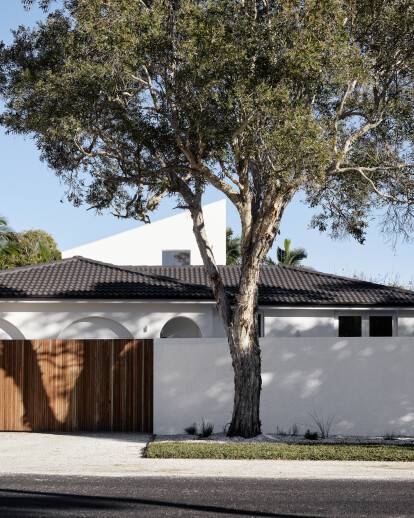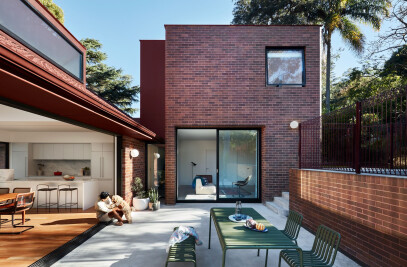COOL WHITE CUBE KNOCKED OVER.
A new house for a family in Byron Bay, Australia.
Designing for the realities of a sub tropical climate – with its harsh sunlight, summer heat and oppressive humidity, winter chills, damp, corrosive air borne salt, high rainfall and occasional tropical storms and fierce winds– requires a deep understanding of the micro climate and the landscape, and how both can be used to create an efficient, functional and delightful place to live.
This new family house in Australia’s Byron Bay, designed by THOSE architects for a young family with their clan of young children, demonstrates how climate can be harnessed to best effect. Distinctly different in form and structure from the local beachside architectural vernacular, its design turns climate challenges to advantage, creating a light filled, generous home that stays cool in the summer and warm in the winter, encourages sea breezes to flow through, and connects every room to the outside, either visually or functionally, or both.
As Simon Addinall, co-director of THOSE, says “Byron is still a coastal town at heart. The local architecture tends to be more ‘nests’ than ‘caves’ - so our work, which is essentially about volume and forms, stands out. We apply the same design principles here as we do in our urban sites in Sydney, or inland, however, different climates produce quite different responses. Summer is long in Byron. You need covered all weather rooms, not just pretty balconies – the sun is far too hot to be unsheltered.”
Here, the architects have achieved this by turning the floor plate on its side, opening it to the north and connecting all spaces via a large courtyard that joins old and new parts of the house, and links all internal spaces to the outside. Lush indoor plants and a palette of natural materials further blur the boundaries between inside and outside, and transcend the essentially suburban character of the site.
“Firstly, we identified the ideal locations on site to position the outdoor spaces in response to the passage of the sun. We then arranged the plan and developed the section to ensure strong connections between inside and outside, public and private space” says co-director Ben Mitchell.
The site is typical of the area, both relatively long and narrow measuring 16m X 40m, with a East/West orientation. Being this close to the beach means it benefits from the cooling NE sea breezes in summer.
The original dwelling was a typical 1980’s mass produced brick house – not at all charming, with its ugly mid brown brick, tiled roof, tiled floors and cheap aluminium windows. Its aesthetics, siting and layout were poor, showing no respect for location, site, geography or local micro-climates. However, it was well built, with double brick walls and an on ground slab.
The decision was taken to retain part of the original dwelling at the front of the block, and to use it to house the children’s bedrooms and service areas of the home – bathrooms, laundry and storage. A generous courtyard acts as the “connector” for the whole house – all spaces open onto or access it. The bedrooms on the southern side of the house can all access the courtyard through breezeway/main hallway, whilst the other bedrooms open directly onto it – likewise the living areas. It means the kids and parents can be in separate parts of the house, yet still connected and close.
To the rear was added a new two-storey volume – mostly hidden from the street behind the original house, with only the top peeking over the existing roof line. It hints at “more” but does not reveal what… The addition hugs the southern boundary, creating a generous, north facing courtyard. The lower floor contains a new living/dining/kitchen space that opens out onto the large north facing courtyard with a pool on the western edge – protected from the fierce afternoon sun.
Above is the main bedroom suite for the parents – bed, walk-in-robe and ensuite. A bank of casement windows open to the NE to capture the prevailing summer sea breezes. Its form is a direct extrapolation of the local council setback controls, yet creates a subtle, sculptural form for the upper floor main bedroom.
Overall, the house is modest in size, and contains only what is needed – no excess.
Additional courtyard spaces are created on the eastern and western edges of the house, providing spaces where the summer sun can be avoided throughout the day. Large sliding doors invite the outside in, enabling inside/outside use of the home through the long warm summers. Openings are limited, and used only where needed – generally to capture breezes or frame views. Deep reveals provide sun and weather protection.
Brick was chosen to reference the original dwelling, with surface treatment of the bricks used to decipher old from new. The original dwelling was rendered with a rough, textured render, while the new addition is face brick painted white. Robust materials are used, designed to withstand young family life and the harsh coastal climate, particularly salt. Limestone paving references the sandy beaches and provides a soft surface to walk on. The hard exterior surfaces are softened internally through timber joinery, linen curtains and soft neutral tones.
The house utilises passive environmental design principles:
- Solar control – Main living areas are oriented to the north. All north-facing windows and doors have extended eaves to block the summer sun while allowing deep interior penetration of the winter sun which tracks much lower in the sky.
- Natural ventilation – All rooms are cross ventilated with windows on opposing or adjacent walls. The main living spaces and principle sleeping spaces are oriented north permitting prevailing summer north easterly winds to passively cool, while the southern elevation is shut down from the prevailing winter south westerly winds.
- Thermal mass – Concrete slabs and brick walls are used throughout, helping to passively heat and cool the home throughout the year.

































